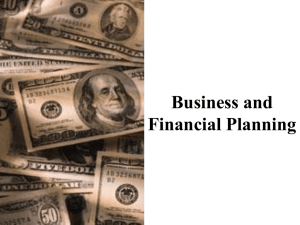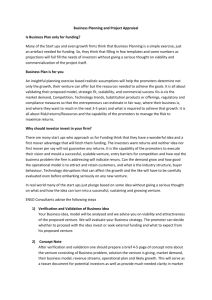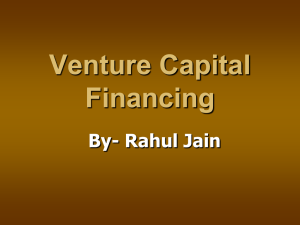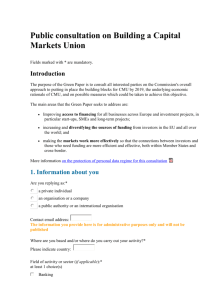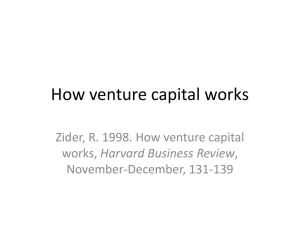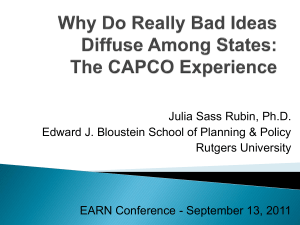Start-Up Companies
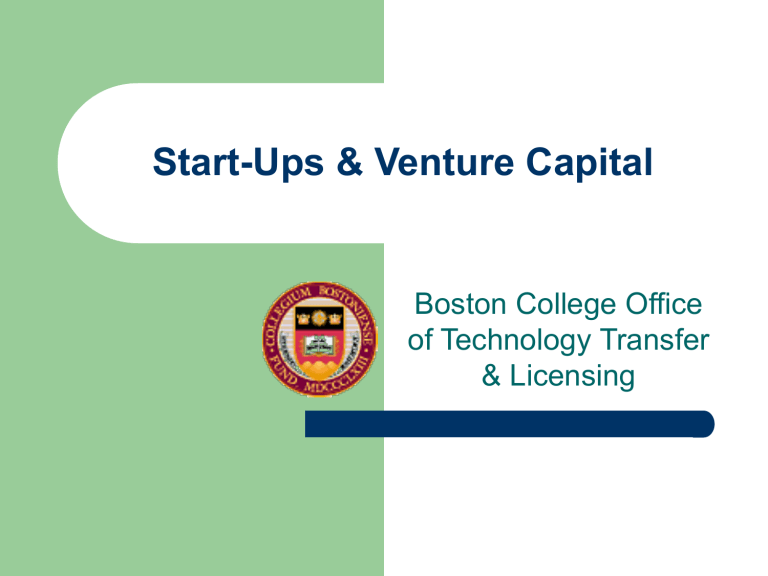
Start-Ups & Venture Capital
Boston College Office of Technology Transfer
& Licensing
Introduction
Since 2000 large companies have been downsizing research arms
Universities, Hospitals, & Research
Institutions had $48.8 billion in research expenditures in 2007
Universities have begun to fill the void due to research cutbacks in the private sector
Why are start-ups sometimes needed?
If an individual technology cannot be licensed piecemeal, a startup is sometimes the only alternative
A startup is a way to translate academic inventions into commercial goods and services that benefit the public
Also serve as an engine for local economic development and job creation
What percentage of inventions become start-ups?
Approximately 5-10% of inventions meet the criteria necessary to become a start-up company
At BC, the actual number is 0-2 start-ups per year depending on the number of invention disclosures and the types of technology disclosed
What does one need to have a successful start-up company?
Not an easy question to answer
A great idea does not necessarily lead to a successful company
According to the Startup Company Bible:
–
“it is ultimately the quality of the management team that builds successful companies rather than their technology”
Considerations
Need to raise capital to fund the development of the technology
Is there a large addressable market?
Inventor will have obligations at the
University, therefore need to recruit an initial management team
What are the terms of license agreement between the university and the company?
Where does the funding come from?
From 2007 AUTM survey
What are Angel Investors?
Invest in companies during the high risk seed stage and very early stage
Tend to be individuals investing their own money as opposed to VCs that manage the money invested in by multiple people
Fill in the gap between “friends & family” and
VC
What is Venture Capital (VC)?
A type of private equity typically provided to earlystage, high-potential, growth companies in the interest of generating a return
–
–
Initial Public Offering (IPO)
Sale of the company
Venture capital fund is a pooled investment vehicle that primarily invests the capital of third party investors in enterprises that are too risky for standard capital markets or bank loans
Know Your Venture Capitalists
Venture partner typically receive 2% of the funds’ committed capital as a management fee + an additional 20% of the funds’ net profits
The structure of the VC fund determines the type of inventions they are interested in
VC funds have a finite lifespan of only a few years
–
–
University research business plans often miss the mark when it comes to addressing the question of timing
VCs typically add 2-3 years to the stated time to market for a university venture
Venture Funds Continued
Software and technology ~5 years
Life sciences ~7-10 years
VCs asses investments in terms of risk
–
A better understanding of a potential company’s risk profile creates a stronger pitch for investors
– Inexperienced management teams and unrealistic claims can turn off would be investors
VC funds are not ATMS
Supporting & Educating
Entrepreneurs
The person behind an idea is as important as the idea itself
Introducing VCs to talented people can be more powerful than specific innovations
The role of the inventor will depend on the maturity of the company
–
–
Should be prepared to follow their technology from the lab to the start up but not necessarily leave the University (ex.
Member of the Scientific Advisory board)
But will probably not run the company through its maturation
Supporting & Educating
Entrepreneurs Continued
Faculty & students’ relative inexperience in founding, growing, and managing successful companies can be an impediment
Faculty members should reach out at others at universities who have experience in the spinout process and whose experiences are similar
Streamlining the Bureaucracy
TT&L Office can help by acting as a business intermediary
–
“Technology transfer should screen and package the technology, make the introduction, then step back and get out of the way” – Partner,
Technology Venture Fund in Southern California
Investors dislike the defensive or “fortress” mentality of attorneys
– Want a genuine effort to make the deal process smooth and expedient
Access & Visibility
Business plans from Universities are usually not as well-developed in terms of what matters most VCs
Packaging ideas in VC-friendly ways
–
Eliminate “academese”
–
–
–
–
–
Be able to discuss ideas in business rather than technological terms
Potential business’ capital requirements
Path to market
Expected return on investment
Avoid “solutions in search of problems”
Access & Visibility Continued
Be able to proactively approach investors with succinct, summarized information about potential deals
–
“elevator pitch” – be able to describe your company in 2 min or less
Distinguish licensing deals from startups
Culture of Innovation
Universities should have an “ecosystem of entrepreneurship” – top to bottom culture that breeds and fosters innovation
Offer university resources to spinouts: continued access to cutting-edge lab facilities for startups is extremely appealing to VCs.
Universities should leverage visibility by partnering with other universities
Build on each other’s successes rather than being competitors
Local Venture Capital Firms
103 Firms listed in the 2009 New England
Technology Directory
Flagship Ventures:
–
–
Founded in 2000 in Cambridge, MA
3 principle business sectors: therapeutics, life science tools
& diagnostics, and bioenergy/cleantech
North Bridge Venture Partners
–
–
Early stage VC in firm based in Boston, MA & San Mateo,
CA.
Industry focus on communications, materials & manufacturing system, semiconductors, & software.
2007 AUTM Survey
In research institutions:
– 555 new startup companies formed
– 3,388 current startup companies in business
AxoGen TM (University of Florida): Nerve regeneration start-up founded in 2002, first product Avance TM used for the treatment of long-gap nerve injuries in 2007
BC Startup: Solasta
Founded in 2006
Developed ultra-high efficiency solar cells using nanoscale elements
Won an undisclosed amount of funding from Kleiner
Perkins Caufield & Byers
Will receive 2.6 million from the U.S. Department of
Energy



